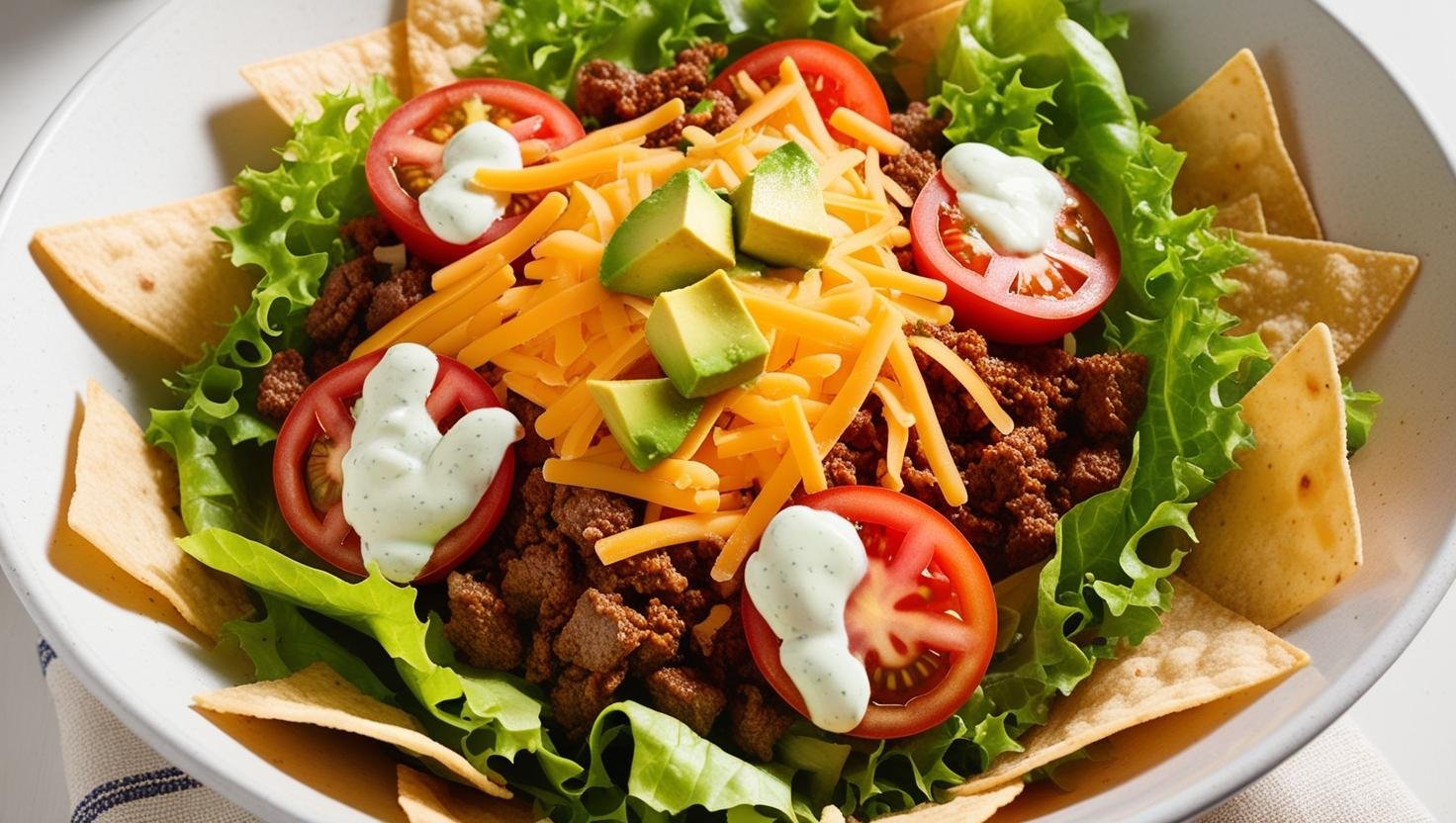Introduction to Taco Salad Recipe
Taco salad is a vibrant and flavorful dish that marries the essence of traditional tacos with the freshness of a salad. This delightful creation originated in the United States, where innovative cooks began to combine the beloved ingredients of Mexican cuisine into a more health-conscious format. The dish typically features a base of crisp greens, such as lettuce, topped with seasoned ground meat, cheese, beans, and a variety of fresh vegetables. The explosion of colors and textures makes taco salad an appealing choice for both casual meals and refined dining experiences.
One of the primary reasons taco salad has gained popularity is its versatility. It can be easily adapted to accommodate various dietary preferences and restrictions, including vegetarian, vegan, and gluten-free options. For instance, incorporating black beans, quinoa, or grilled vegetables can create a savory and satisfying vegetarian taco salad. Additionally, using corn tortillas instead of traditional tortilla chips or opting for a gluten-free grain like brown rice can ensure that those with gluten sensitivities can enjoy this dish without compromising on flavor.
The freshness that taco salad brings to the table is unparalleled. The combination of crisp greens, juicy tomatoes, and sharp cheese, accompanied by zesty dressings—often made with lime or cilantro—ensures that each bite is bursting with taste. Whether enjoyed as a light lunch, a hearty dinner, or a party appetizer, taco salad offers a unique balance of nutritional value and indulgent flavor. With countless variations available, it allows individuals to customize their meals to their liking, making it a cherished staple in many households.
Also Read:
Ingredients You’ll Need
Creating a delicious taco salad requires a variety of fresh ingredients that contribute to a harmonious blend of flavors. To start, we need a robust salad base, which typically includes crunchy lettuce and ripe tomatoes. Iceberg or romaine lettuce works well, providing the necessary crispness, while tomatoes, preferably diced, add juiciness and sweetness.
Next, selecting the right protein is essential to enrich the taco salad. Common choices are ground beef or chicken, seasoned to perfection, offering a hearty component. Alternatively, for those preferring a vegetarian option, black beans or kidney beans serve as excellent substitutes, packed with protein and fiber while adding texture to the dish.
To elevate the flavor profile, toppings play a critical role. Shredded cheese, such as cheddar or Monterey Jack, contributes a creamy richness. Diced avocado or guacamole adds a buttery texture, while sour cream delivers a tangy finish. You may also consider including jalapeños for a spicy kick, or corn for a sweet crunch.
Now, let’s not forget the dressing, which ties all components together. A traditional taco salad often features a zesty ranch or a cilantro-lime vinaigrette. For a lighter option, consider a simple olive oil and lime juice combination, which complements the ingredients beautifully.
It’s also important to accommodate various dietary preferences. Those on a gluten-free diet can easily modify the recipe by ensuring all sauces and dressings are gluten-free. Likewise, for a lower-carb version, you can use lettuce wraps instead of chips. With these ingredients and tips, you can customize your taco salad to suit every taste and dietary need.
Step-by-Step Preparation Instructions
Preparing a delicious taco salad involves several straightforward steps that will guide you through the process, ensuring a perfect mix of flavors and textures. Start by gathering all necessary ingredients: ground meat or beans, lettuce, tomatoes, onions, bell peppers, cheese, sour cream, guacamole, and taco seasoning.
Begin by cooking the protein. If you choose ground meat, heat a skillet over medium-high heat and add the ground beef or turkey. Cook thoroughly, breaking it apart with a spatula until it browns completely, typically between 7-10 minutes. During the last few minutes of cooking, sprinkle in taco seasoning and a splash of water, stirring to combine. For a vegetarian option, use canned black beans, rinsed and heated in a saucepan with a sprinkle of taco seasoning until warm.
Once the protein is ready, it’s time to prepare the vegetables. Start with the lettuce: wash and thoroughly dry a head of romaine or iceberg lettuce. Chop it into bite-sized pieces or shred it as preferred. Then, dice tomatoes, finely chop onions, and slice bell peppers into thin strips. For added flavor, consider squeezing some lime juice over the chopped vegetables.
Next, the assembly of the taco salad can take place. Begin by layering the chopped lettuce as the base in a large bowl or serving platter, creating a bed for the subsequent ingredients. Evenly distribute the cooked protein or beans atop the lettuce, followed by the diced tomatoes, onions, and bell peppers. Add a generous sprinkle of shredded cheese. For the final touches, include dollops of sour cream and guacamole on top. Consider garnishing with fresh cilantro or sliced jalapeños for extra flavor.
To make the preparation quicker, try chopping the vegetables ahead of time and storing them in an airtight container. Layering the salad not only enhances presentation but also helps keep the ingredients crisp until serving. Once everything is assembled, serve immediately for the best flavor and texture, or chill briefly to enhance the experience.
Serving Suggestions and Variations
Taco salad is a versatile dish that can be tailored to suit various tastes and occasions. One popular way to serve taco salad is alongside crispy tortilla chips or guacamole, which adds an appealing crunchy texture and rich flavor. For those looking to enhance their dining experience further, incorporating homemade salsa or sour cream can complement the freshness of the salad and create a more substantial meal.
When it comes to variations, taco salads can be easily customized by altering the protein source. While seasoned ground beef is a classic choice, options like grilled chicken, shrimp, or even a vegetarian blend of beans and lentils can cater to different dietary preferences. Additionally, experimenting with dressings can elevate the overall taste; a zesty lime vinaigrette or a creamy ranch dressing can add a delightful twist to your salad. Incorporating seasonal ingredients, such as grilled corn in summer or roasted butternut squash in fall, also provides an opportunity to refresh the dish throughout the year.
For parties or gatherings, consider creating a taco salad bar, allowing guests to build their own salads with a variety of toppings, such as diced tomatoes, shredded cheese, and fresh cilantro. This interactive element not only makes for a fun dining experience but ensures that each guest can customize their dish according to their preferences.
Lastly, storing leftover taco salad is simple and ensures that it remains fresh. To keep the ingredients crisp, it is advisable to store dressing separately and combine it only when ready to eat. Airtight containers can help prolong the freshness of the salad, making it a convenient option for meal prep throughout the week. By following these suggestions and variations, you can create a delightful taco salad that satisfies various tastes and occasions.


